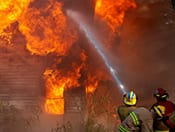Terms under Meaning of STFI
Storm
A storm is referred to as a natural phenomenon which might occur on land or water. Under the fire insurance policy, a storm relates to extreme weather having the potential to cause major damage or destruction to the insured property. In fire insurance, a storm can also be referred to as an atmospheric disturbance that occurs due to rains, snow, lightning or winds.
However, these atmospheric disturbances are common and usually do not cause significant destruction to the property. Therefore, any losses that occur due to these occurrences could be indemnified under the fire insurance policy.
Cyclone
A cyclone may cause significant loss across a town or city and devastate various livelihood and business premises. It encloses the capacity to cause massive damage and destruction if it occurs. Therefore, it is also known as a violent storm. It generally forms from the Indian Ocean and south pacific regions and can wreak dangerous winds which may exceed the speed of 280Km/h.
Hence, a fire insurance policy can be obtained in order to cover the damage or destruction that took place due to the cyclone.
Typhoon and Hurricane
Typhoons and Hurricane are similar phenomena known by different names. A typhoon is a tropical storm, and the speed of the wind during a typhoon may exceed 119 km/h. Hence it may cause massive destruction of insured property covered under the fire insurance policy.
Hurricanes are more prone in the Caribbean region and usually arise in countries such as China, Japan and Vietnam. Hurricane generally forms over hot or warm waters, which might destroy the insured property. Therefore, the losses caused due to hurricanes are covered under the fire insurance policy.
Tempest
A tempest is a violent wind or storm that materializes in snow and rain. It is contained in the term of fire insurance since various cases of losses were taken place due to disruption of the tempest.
Tornado
Tornado generally forms vortex on the land. Therefore, when it occurs, and if the insured property comes in the transmission of the vortex, there is no possibility for the property to escape from its involvement. Hence, the losses occur due to Tornado cover under the fire insurance policy.
Flood and Inundation
Heavy rain or storms may result in a flood which may cause significant deterioration to the assets. States such as Uttar Pradesh, Punjab, Haryana and Gujarat are more prone to floods. Hence it is covered under the fire insurance policy.
Inundation can also be referred to as flood. It occurs due to overflow of water, which may submerge or drown the area. Hence, the losses due to Inundation may be covered under the fire insurance policy.
Case Study
General Assurance Society Ltd v. Chandumull Jain And Anr
In this case, while examining the meaning of STFI, the Supreme Court passed the decree in favor of the appellant, a cyclone victim. The complainant pleaded before the apex court after being repudiated by the insurer to settle the claim. However, the apex court held that any losses due to STFI could be covered under the fire insurance policy.
Conclusion
The meaning of STFI, FLEXA and RSMD is crucial to understand in order to comprehend the scope of the fire insurance policy. For example, the policyholder could get indemnified under fire insurance if the destruction against the insured property occurred due to natural calamities.






















 Expert advice made easy
Expert advice made easy


